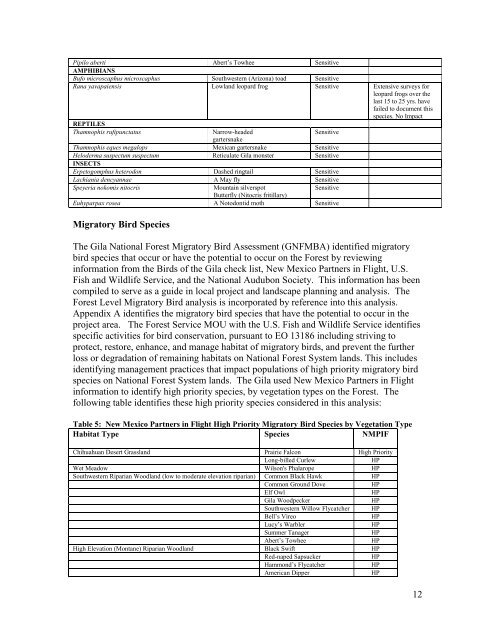Wildlife Specialist report
Wildlife Specialist report
Wildlife Specialist report
Create successful ePaper yourself
Turn your PDF publications into a flip-book with our unique Google optimized e-Paper software.
Pipilo aberti<br />
AMPHIBIANS<br />
Abert’s Towhee Sensitive<br />
Bufo microscaphus microscaphus Southwestern (Arizona) toad Sensitive<br />
Rana yavapaiensis<br />
REPTILES<br />
Lowland leopard frog Sensitive Extensive surveys for<br />
leopard frogs over the<br />
last 15 to 25 yrs. have<br />
failed to document this<br />
species. No Impact<br />
Thamnophis rufipunctatus Narrow-headed<br />
gartersnake<br />
Sensitive<br />
Thamnophis eques megalops Mexican gartersnake Sensitive<br />
Heloderma suspectum suspectum<br />
INSECTS<br />
Reticulate Gila monster Sensitive<br />
Erpetogomphus heterodon Dashed ringtail Sensitive<br />
Lachiania dencyannae A May fly Sensitive<br />
Speyeria nokomis nitocris Mountain silverspot<br />
Butterfly (Nitocris fritillary)<br />
Sensitive<br />
Euhyparpax rosea A Notodontid moth Sensitive<br />
Migratory Bird Species<br />
The Gila National Forest Migratory Bird Assessment (GNFMBA) identified migratory<br />
bird species that occur or have the potential to occur on the Forest by reviewing<br />
information from the Birds of the Gila check list, New Mexico Partners in Flight, U.S.<br />
Fish and <strong>Wildlife</strong> Service, and the National Audubon Society. This information has been<br />
compiled to serve as a guide in local project and landscape planning and analysis. The<br />
Forest Level Migratory Bird analysis is incorporated by reference into this analysis.<br />
Appendix A identifies the migratory bird species that have the potential to occur in the<br />
project area. The Forest Service MOU with the U.S. Fish and <strong>Wildlife</strong> Service identifies<br />
specific activities for bird conservation, pursuant to EO 13186 including striving to<br />
protect, restore, enhance, and manage habitat of migratory birds, and prevent the further<br />
loss or degradation of remaining habitats on National Forest System lands. This includes<br />
identifying management practices that impact populations of high priority migratory bird<br />
species on National Forest System lands. The Gila used New Mexico Partners in Flight<br />
information to identify high priority species, by vegetation types on the Forest. The<br />
following table identifies these high priority species considered in this analysis:<br />
Table 5: New Mexico Partners in Flight High Priority Migratory Bird Species by Vegetation Type<br />
Habitat Type Species NMPIF<br />
Chihuahuan Desert Grassland Prairie Falcon High Priority<br />
Long-billed Curlew HP<br />
Wet Meadow Wilson's Phalarope HP<br />
Southwestern Riparian Woodland (low to moderate elevation riparian) Common Black Hawk HP<br />
Common Ground Dove HP<br />
Elf Owl HP<br />
Gila Woodpecker HP<br />
Southwestern Willow Flycatcher HP<br />
Bell’s Vireo HP<br />
Lucy’s Warbler HP<br />
Summer Tanager HP<br />
Abert’s Towhee HP<br />
High Elevation (Montane) Riparian Woodland Black Swift HP<br />
Red-naped Sapsucker HP<br />
Hammond’s Flycatcher HP<br />
American Dipper HP<br />
12
















